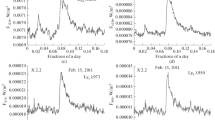Abstract
Under solar flare conditions, the intensity of the solar X-rays below 10 Å increases by several orders of magnitude, while the increase in intensity of H-Lα is small. Photo-ionization rates in the various wavelength bands in theXUV spectrum have been presented graphically as a function of altitude under quiet, M3, X4, and outstanding flare conditions to show the relative importance of solar X-rays below 10 Å in the height range between 50 and 90 km. Presuming the total time constant for recombination of the ions with electrons remains constant at each altitude under different flare conditions, one can obtain the effective recombination coefficient ψeff under these conditions with a knowledge of the quiet time recombination coefficient, the production rate profiles and λ profiles. The importance of the ratio λ of negative ions to electrons below 70 km in lowering the effective electron loss rates has been highlighted.
Similar content being viewed by others
References
Balachandra Swamy, A. C. and Setty, C. S. G. K.:Adv. Space Res. 4, 41.
Balachandra Swamy, A. C. and Setty, C. S. G. K.:Indian J. Radio Space Phys. (Inida) 18, 265.
Bjorn, L. G., Arnold, F., Krankowsky, D., Grandal, B., Hagen, O., and Thranex, E. V.: 1979,J. Atmospheric Terrest. Phys. 41, 1184.
CIRA: 1971,Cospar International Reference Atmosphere, North Holland, Amsterdam.
Deshpande, S. D. and Mitra, A. P.: 1983,Scientific Report, ISRO-IMAP-SR-11-83.
Friedrich, M., Torkar, K. M., Rose, G., and Widdel, H. U.: 1979,J. Atmospheric Terrest. Phys. 41, 1163.
Huffman, R. E., Paulsen, D. E., Larrabee, J. C., and Cairns, R. B.: 1971,J. Geophys. Res. 76, 1028.
Mitra, A. P.: 1977,Scientific Note, ISRO-INCOSPAR-SN-03-77.
Mitra, A. P. and Rowe, J. N.: 1972,J. Atmospheric Terrest. Phys. 34, 795.
Montbriand, L. E. and Belrose, J. S.: 1972,Radio Sci. (Britain) 1, 133.
Paulsen, D. E. Huffman, R. E., and Larrabee, J. C.: 1972,Radio Sci. 7, 51.
Poppoff, I. G., Whitten, R. C., Gunton, R. G., Evans, J. E., and Joki, E. G.: 1971, ‘Reaction Rate Data from Atmospheric Measurements’,Data Reaction Rate Handbook, Chapter 8 (revised edition).
Reagan, J. B. and Watt, I. M.: 1976,J. Geophys Res. 81, 4579.
Swider, W. and Dean, W. A.: 1975,J. Geophys Res. 80, 1915.
Velinov, P.: 1968,J. Atmospheric Terrest. Phys. 30, 1891.
Author information
Authors and Affiliations
Rights and permissions
About this article
Cite this article
Balachandra Swamy, A.C. A new technique for estimating D-region effective recombination coefficients under different solar flare conditions. Astrophys Space Sci 185, 153–164 (1991). https://doi.org/10.1007/BF00642713
Received:
Issue Date:
DOI: https://doi.org/10.1007/BF00642713




